Since we lived in Oman for six years many people have told us that they want to visit Oman, but don’t know what it’s like. Well, let me tell you: this is a beautiful country with so much history and culture! From the charming village of Misfat al Abriyeen to the old souq marketplaces in Nizwa. From modern Oman’s Capital City – Muscat to the oldest beehive tombs. Everything in Oman is fascinating and ready to be discovered, plus Omani people are the most friendly and hospitable people we have ever met. Enjoy reading Interesting Facts about Oman.
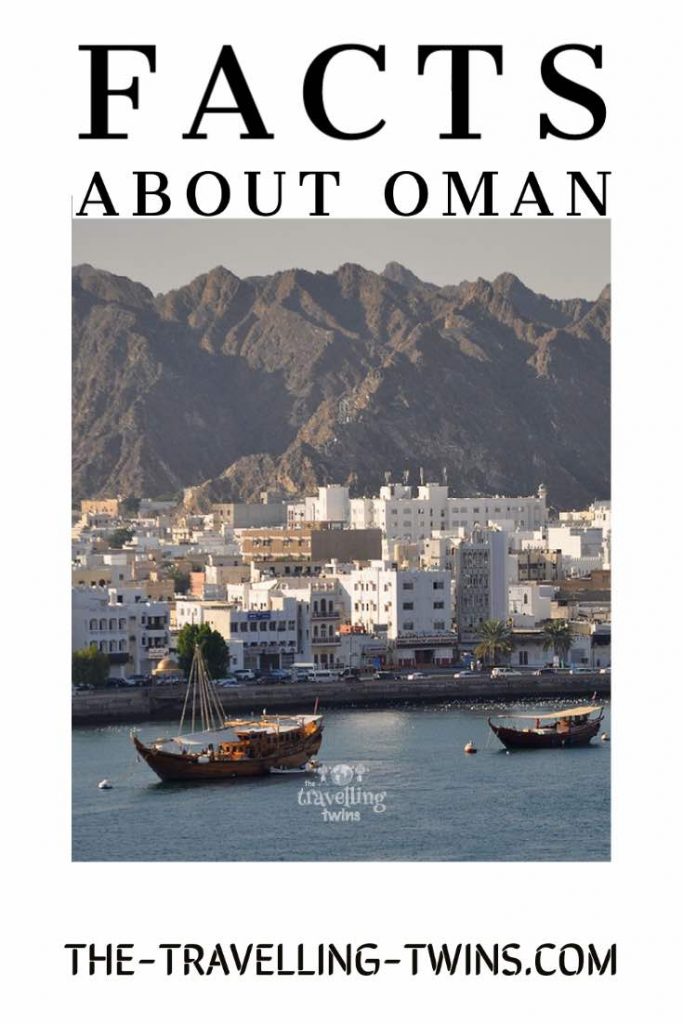
Oman Capital
The capital city for Oman is Muscat and it is on the coast. This city has a population is around 1,4 million people and it also has a large number of foreigners living there.
Another thing to note about Muscat is that it is the country’s main political, economic, and cultural centre.
The country’s capital contains important Omani government buildings like the Royal Palace Complex, which was built by Sultan Qaboos in 1985.
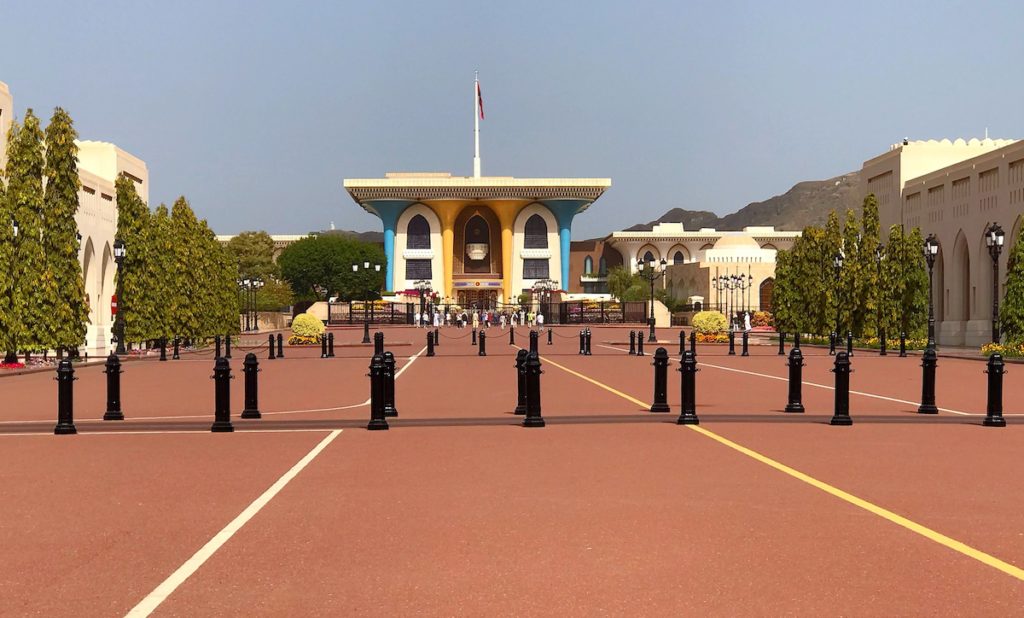
Even though Muscat is a city with over 900 years old tradition only after 1970 it started to grow rapidly. And especially in the last 20 years when the country has transformed from a small agriculturally based economy to a developing country with its own modern infrastructure.
The new and impressive buildings which recently (last 10 years) you can see in the capital of Oman are Sultan Qaboos Grand Mosque, Royal Opera House Muscat, Bait Al-Baranda Museum and Sultan Qaboos University and several new hotels.
But the city didn’t lose its own old middle east character. you just need to visit Muttrah souq and again you back in time.
Oman is a member of the United Nations and the Arab League.
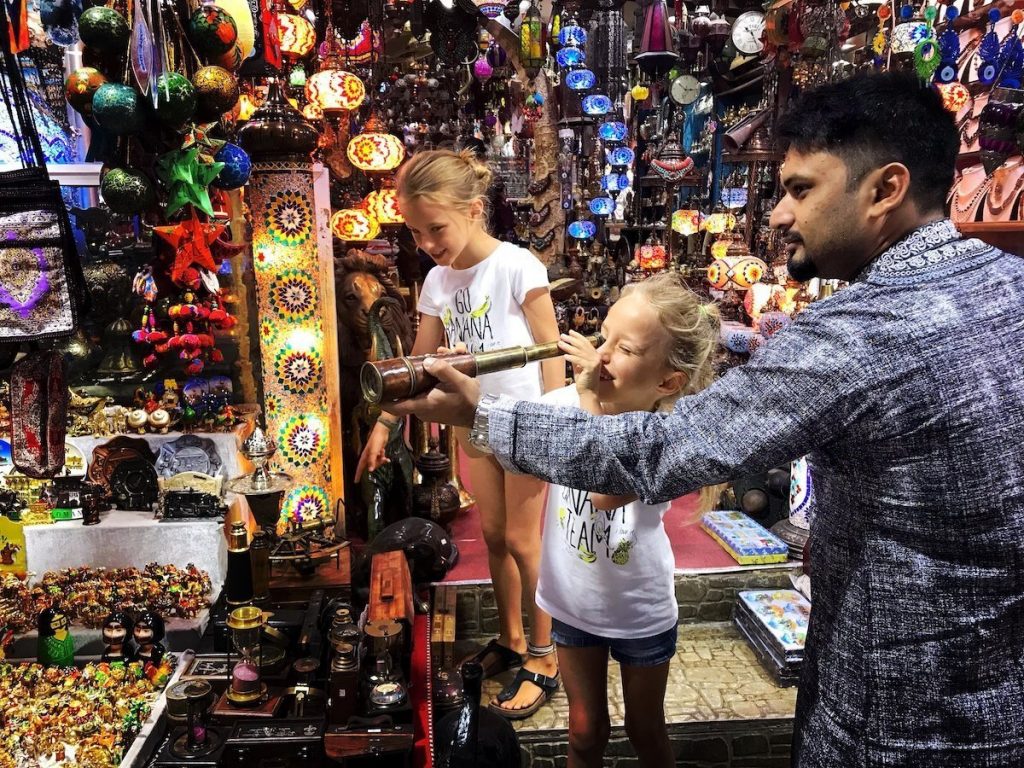
Oman location
Oman is a country located on the Arabian Peninsula with a 1700 km coastline along the Arabian Gulf and the Indian Ocean (Arabian Sea). Oman is bordered by the United Arab Emirates on the northwest, Saudi Arabia on the west and south, and Yemen on the southeast. Oman has two exclaves separated from it by the United Arab Emirates: Madha and the Musandam Peninsula.
Oman has an overall size of 309,500 sq km.
Population in Oman
The overall population of Oman is estimated at around 4.9 million people. With Omani being around 60% of the country’s total population while the rest are ex-pats. Mostly cheap construction labour from South Asia and domestic help from Sri Lanka, Philippines. there are as well quite a few skilled professionals from Western Countries but the number is going down due to “Omanization” – educating and employing Omanins on all professional levels.
Omani National Flag and National Symbol
The flag of Oman is a tricolour with a vertical red stripe at the hoist, bearing the National emblem – khanjar ( ceremonial dagger) with two crossed swords. This flag design got adopted in 1995, the earlier the flag had a thinner middle stripe, and the first Omani flag was red.
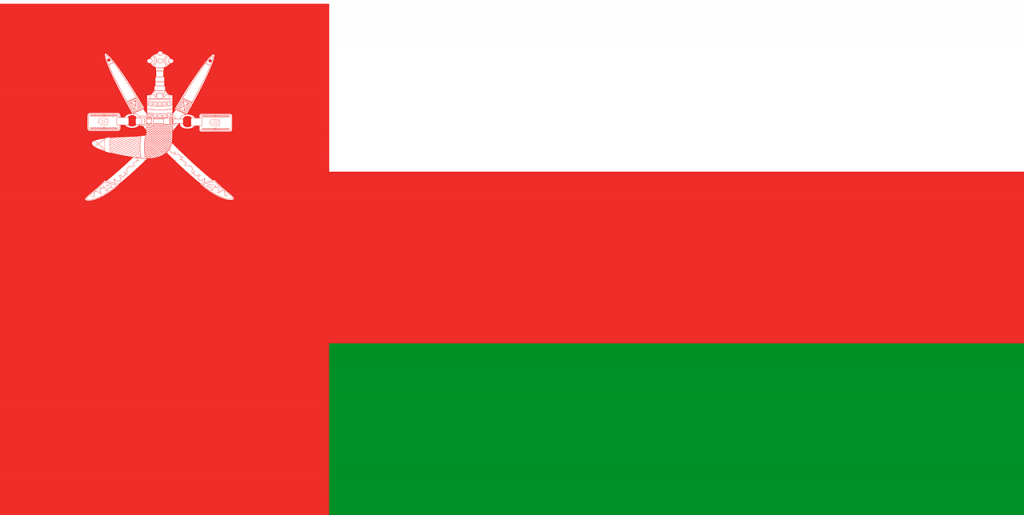
Meaning of the colours
The White colour symbolizes peace and the Imam, the religious leader of Oman’s Sultanate.
The Green represents the Jabal al-Akdar, (translation from Arabic “The Green Mountains) located two hours away from Muscat.
The Red colour is adopted from the first Omani flag which was whole red and symbolize the fights Omani fought against foreign invaders. Red is quite a common colour in all flags in the Arab world.
The national animal of Oman is the Oryx – a rare type of antelope. There are around 1000 left in Oman.
Oman’s Economy
Oman has a diversified economy including oil, tourism, fishing. Oil exports are still the base of the Omani economy, with over 70% of the total GDP. Tourism is the second biggest income provider, with a lot of money going into development and promoting the country. Fishing is important as well but it is rather a small part of the overall economy.
Facts about Safety in Oman
When we were living in Oman with kids and when I explored the country on my with kids (we visited turtle sanctuary and lots of wadis)lots of people were asking me did I felt safe. the answer is YES. Oman is a terrorism free country and even more is one of the safest countries in the world to live in, with a low crime rate. Women are well respected and can even walk around on their own at night if they feel like it. Women have the same rights as men, including driving a car, voting rights etc.
Women Dress Code in Oman
What we see in movies – Arab ladies wearing Abaya and covering their face in Oman is optional. Omani women depending on their family and education may choose to wear or not wear abaya and scarf. Some will wear it but keep the face uncovered, some may wear traditional dress and cover the face with a niqab.
From their point of view – and I talked to many of them wearing an abaya is like wearing tracksuits. You can wear PJ, quickly put on an abaya and you off shopping with no one knowing that you are still in your pyjamas.
Non-Muslims women can dress as they want, providing it will be modest. The only time when I had to wear an abaya was during the visit to Sultan Grand Qaboos Mosque. Same time men visiting the mosque cannot wear shorts, so it seemed fair.
Sultan Qaboos bin Said
Sultan Qaboos bin Said was the ruler of Oman from 1970 until his death in 2020. He took over Oman after the palace coup against his father Said bin Taimur. During his reign, Sultan Qaboos turned Oman into an open economy by going from a closed state to a most favoured nation with most countries
Sultan Qaboos had absolute power was loved by all Omani and respected in the western world as being progressive, modern and willing to share Oman’s wealth with the nations who helped build up Oman.
He acted as a mediator in many conflicts in the middle east. He didn’t have any children and after his death new sultan became Haitham bin Tariq al Said the cousin of the late Sultan Qaboos.
Sultan Qaboos bin Said was the longest-serving ruler in the Middle East and Oman is the oldest independent state in the Arab World. Omani Al Said Family rules the country since 1744
Sultan Qaboos Grand Mosque
Currency in Oman – The Omani Rial
The Omani Rial is the official currency of Oman. The Omani riyal is divided into 1000 baisa with sub-units of 5 baisas. Coins are available in denominations of 1, 5, 10, 20 and 50 baisa while banknotes are available in denominations of OMR1, 2,
Facts about Drinks in Oman
On many websites with Oman Facts, you can read that there are no Coca Cola products in Oman. Maybe it was the case 10-20 years ago, now Coca-Cola, as well as Pepsi, is available everywhere. However, the top-selling beverage is Mountain Dew due to its high sugar content. Omani Government to reduce the sale of high sugar drinks in 2020 introduced a 50% tax on all sweetened drinks
Omani Coffee
Coffee has been an important part of Omani culture for centuries. Omanis are known for their traditional Arabian coffee, which is made with cardamom pods, cinnamon sticks and cloves. Some people enjoy adding various amounts of sugar or honey. Or black with Omani dates.
Dates are another important traditional food in the Omani diet. They are eaten fresh or dried and are soaked in hot water to make tea, sometimes mixed with other ingredients like milk, sugar or ginger to make it sweeter.
Licence for alcohol
Since Oman is a Muslim country and Muslim religion doesn’t allow drinking alcohol. To be able to buy alcohol in an off-licence shop you must obtain a special licence. to get it you need an agreement from your employer plus the report about your salary, as the sum of monthly alcohol allowance cannot be higher than 10% of your income.
Working and Living in Oman
Oman is a great place to work for a number of reasons – the country does not levy income tax and there are no major restrictions on foreign ownership. Foreigners can buy property in dedicated modern developments like Al Mouj (Wave) in Muscat.
Oman has also been listed as one of the top 10 countries in the world to do business for the second year in a row. In addition, it has been ranked as one of the best states in the Middle East to find work
UNESCO World Heritage Site in Oman
Oman is home to five Unesco World Heritage Sites. These include the Bahla Fort, the Archaeological Sites of Bat, Al-Khutm and Al-Ayn, the Land of Frankincense, Al Aflaj Irrigation Systems of Oman.
Fauna in Oman
Like many deserts, there is also wildlife that lives here. Animals like sand grouse, sand cats, civets, hares, desert hedgehogs and camels are all native to the desert. Some of them are even endangered species.
Turtles
Turtles are also unique to Oman. Turtles can be found in Ras Al Jinz, on the coast of Muscat. The Turtle Sanctuary is a non-profit organization dedicated to the conservation of sea turtles, especially loggerheads.
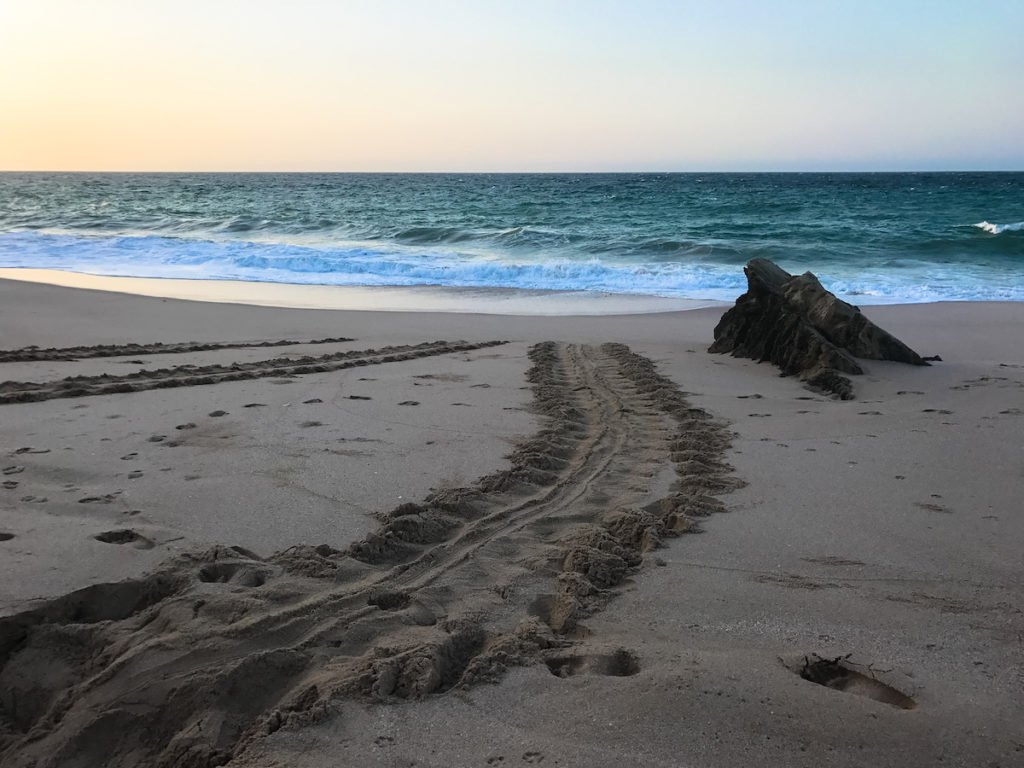
Arabian Oryx
The Arabian oryx was a species that nearly died out due to overhunting. The oryx became an endangered species and it was restricted to a single country, the United Arab Emirates. In 1967, Saad Bin Sultan Al Darmaki founded a society known as the Arabian Oryx Sanctuary for the protection of these animals. The organization has been successful in bringing back the oryx from being on the brink of extinction to being an animal that can be found in its natural habitat.
Arabian Horses
The Arabian Horses is one of the most uniquely bred horses in the world, which originated from Arabian Penisula. It is one of the oldest breeds and almost all horse breeds can trace their lineage back to this animal. The Omani are the finest breeders of Arabian horses are specifically known for their endurance, speed and beauty.
Camels
Most of the animals in Oman are desert animals and there is a wide variety. They range from sandgrouse and sand cats to civets, hares and camels
Camels come from Arabia and were used for travelling across the vast desert as well as the main way of transportation. Currently, camels are used for racing plus believe it or not there are camel beauty competitions held in Oman.
Goats
Goats in Oman are mostly found in small villages and temporary settlements. Goats provide much-needed meat for the residents there and their hair is used to make clothing. The majority of goat herders are women because it is an occupation passed down from generation to generation. Goats are being held for the meat and the milk.
Frankincense trees
Frankincense trees are native to the Middle East and in Oman, they can be found in Dhofar. They grow right on the border of the Arabian Peninsula and the Horn of Africa.
Frankincense trees have a history that dates back to before Christ was born when traders would use them as a form of payment. Frankincense trees were also a symbol of peace. The frankincense tree has been used for many different purposes over time, from being burned by Roman priests to being used for medicinal purposes.
In Oman, frankincense incense is used for things like burning, perfume, chewing and medical purposes.
Best time to visit Oman
The best time for visiting Oman is from November to March, as this is when the weather is most pleasant. In summer the temperature can rise as high as 50 degrees Celsius and humidity is also extremely high, making it a less than ideal time to visit. Making it one of the hottest countries in the world.
on the other hand, Salalah in Dhofar region, on the border with Yemen is famous for its pleasant weather and pleasant climate in summer. There is a special festival Khareef – monsoon festival in August / September where most of the people from the rest of Oman visit Salalah, the southern region of Dhofar for this occasion.
Khareef means “autumn” in Arabic.
Weekends in Oman
When we move into Oman weekends were Thursday Friday, where Thursday was the equivalent of western Saturday and Friday to Sunday. But now in Oman, Saturday and Friday is a weekend holiday. Friday is a day when all Muslims go to the mosque and do their prayer. The biggest mosque in Oman is Sultan Qaboos Grand Mosque in Muscat.
Sultan Qaboos Grand Mosque
Sultan Qaboos Grand Mosque is one of the biggest mosques in the world and also the largest mosque in the Middle East. It has the largest chandelier in the world and the second world’s largest hand-knotted carpets just after Sheik Zayed Grand Mosque in Abu Dhabi. Here you can see more photos and read about Sultan Qaboos Grand Mosque and our visit to it.
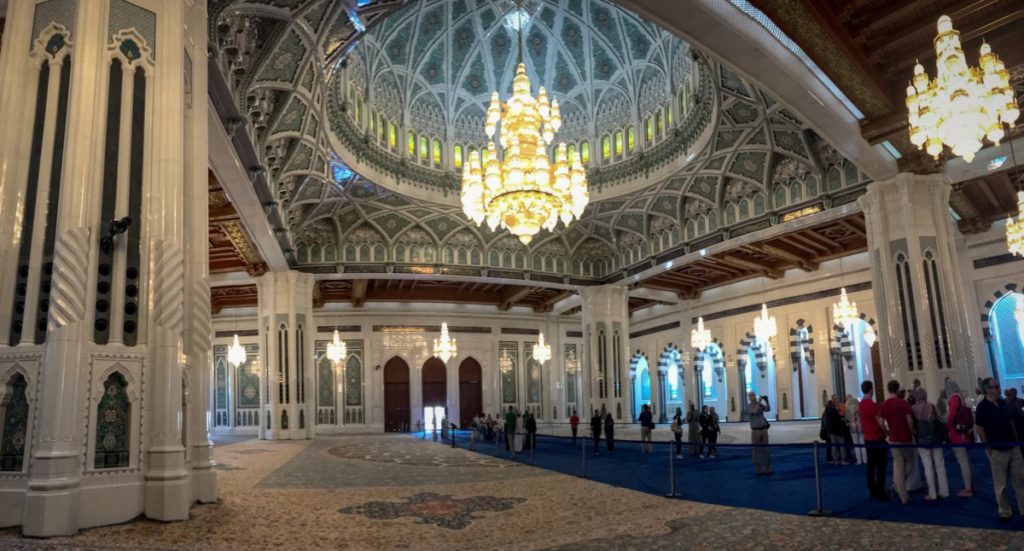
Short Interesting Oman Facts
Oman abolished slavery in 1970, which makes it one of the last countries to do so.
It’s true that Oman has a desert climate, but it can snow in Oman. You just have to be in the right place at the right time. Like on Jebel Akhdar.
The combination of Oman’s location at the crossroads of three continents and its diverse birdlife makes it an ideal spot for ornithologists. There are more than thirty species found in this small country alone, including some unique ones like The Omani Owl or Rufous Scrub Robin!
Omani people were considered to be the greatest ship builders in the world, with their dhows being a key transport across the Indian Ocean. You can still see how the traditional boats being build in Sur.
Modern Oman Facts – Summary
Hopefully reading these facts makes you choose Oman as your next holiday destination. Trust me, it’s worth it and even better if you connect your holiday in Oman with the visit to Dubai and Abu Dhabi.
Interesting Facts about Oman – Pin it For later



Privacy Policy Disclaimer
This website uses affiliate links for income and support.
If you like our website, please consider using these links. You will be directed to the vendor, and we will get a small commission on your purchase price at no increased cost to you.
We have researched facts stated here as far as practicable but please check anything critical before committing your time and money. We do not claim any special knowledge or expertise, and we are not consultants for our readers.